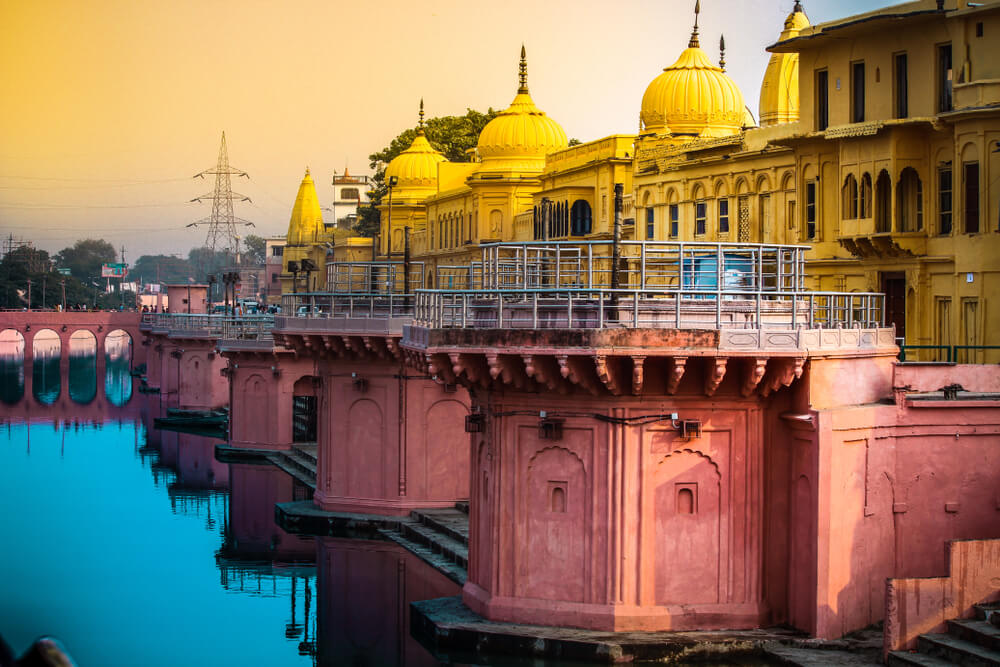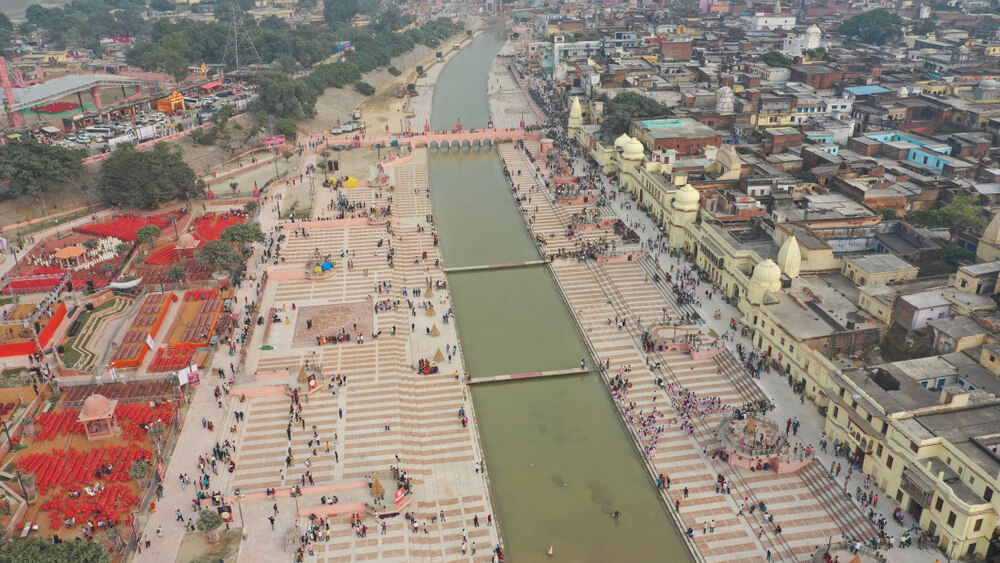Cultural and Religious Significance – Where is Ayodhya located?
In answering Where is Ayodhya located?, one not only pinpoints a city in Uttar Pradesh, India but also identifies a hub of rich cultural and religious significance. Ayodhya, renowned as a pivotal spiritual centre, has been at the heart of numerous cultural and religious narratives, each contributing to its sacred aura.
Ayodhya’s cultural landscape is dominated by its numerous temples and religious monuments, each bearing historical and mythological importance.

For instance, the Hanuman Garhi Temple revered for its impressive architecture and religious value, and the Kanak Bhawan, known for its beautiful idols of Sri Rama and Sita, are central to Ayodhya’s spiritual identity. These temples are not just places of worship but are embodiments of the city’s historical and religious journey through time.
The city’s religious significance extends beyond its temples. Ayodhya is also known for its vibrant religious festivals and events that attract devotees from across the globe. The Ayodhya Deepotsav during Diwali, a festival that marks Lord Rama’s return to Ayodhya, is celebrated with great fervour and grandeur, lighting up the city in a spectacle of joy and devotion.
Similarly, the enactment of the Ram Lila, which dramatizes the life of Lord Rama, is a culturally rich tradition, showcasing the city’s deep connection with the Ramayana and its characters.
Ayodhya’s cultural and religious significance is further enhanced by its multi-religious history. It is not only significant in Hinduism but also holds importance in Buddhism and Jainism.
This interweaving of multiple religious traditions has endowed Ayodhya with a unique and inclusive cultural identity. The city, thus, stands as a testament to India’s composite cultural fabric, where different religious narratives coexist and flourish.
Therefore, Ayodhya’s location on the map is more than a set of geographical coordinates; it’s a symbol of India’s diverse religious heritage and cultural depth. The city’s cultural and religious significance is a beacon that continues to attract scholars, devotees, and tourists, eager to experience its sacred atmosphere and explore its historical richness.

For a more detailed understanding of Ayodhya’s cultural and religious importance, diving into resources like travel guides, historical texts, and religious studies can provide a comprehensive view.
Recent Developments
The query Where is Ayodhya located? not only directs one to a historical and religious landmark in Uttar Pradesh, India but also to a site of ongoing and significant developments. In recent years, Ayodhya has been at the centre of several key developments that have shaped its contemporary identity and added new chapters to its long history.
One of the most pivotal recent events in Ayodhya has been the resolution of the long-standing Ram Janmabhoomi dispute. This dispute centred around the site believed to be the birthplace of Lord Rama, had been a focal point of religious and political contention for decades.
The 2019 Supreme Court verdict, which allocated the disputed land for the construction of a Hindu temple and provided an alternative site for a mosque, marked a significant turning point. This decision not only impacted the religious landscape of Ayodhya but also had far-reaching implications across India.
Following this verdict, the construction of the Ram Mandir (temple) commenced in August 2020, signalling a new era in Ayodhya’s history. This development has renewed interest in Ayodhya, both as a religious destination and as a symbol of the Hindu faith.

The temple’s construction has been accompanied by various infrastructural and developmental projects aimed at enhancing the city’s capability to accommodate the increasing number of pilgrims and tourists.
Moreover, Ayodhya’s cultural and religious profile has continued to evolve with the establishment of new landmarks and initiatives. Projects like the planned Ramayan Wax Museum and the development of the Ayodhya airport are examples of how the city is adapting to its growing significance as a major pilgrimage and cultural destination.
These recent developments in Ayodhya are not just about physical construction or infrastructure enhancement; they represent a profound transformation in the city’s cultural and religious narrative. As Ayodhya continues to evolve, it strengthens its position as a key destination for those seeking to connect with India’s rich spiritual heritage.
In summary, when one seeks the location of Ayodhya, one finds a city dynamically weaving its ancient past with its evolving present, standing as a testament to India’s diverse and ever-changing cultural landscape. For more detailed information about the latest developments in Ayodhya, exploring news articles, government announcements, and cultural reviews can provide a current perspective.
Travel and Tourism
Exploring Where is Ayodhya located? from a travel and tourism perspective reveals Ayodhya as a destination with a blend of spiritual allure, historical intrigue, and cultural richness. Situated in Uttar Pradesh, India, Ayodhya is not only a magnet for pilgrims and devotees but also for travellers seeking to immerse themselves in a place steeped in mythological and historical significance.
Tourist Attractions
Ayodhya, renowned for its temples and religious sites, offers a diverse array of attractions. The Hanuman Garhi Temple, known for its unique architecture, and the Ram ki Paidi ghats, especially vibrant during the Ayodhya Deepotsav, are must-visit locations. Additionally, the Kanak Bhawan and Nageshwarnath Temple provide insights into the city’s rich religious traditions and architectural beauty.
Cultural Experiences
The city is a hub for experiencing Hindu culture and traditions. Visitors can witness the enactment of Ram Lila, a dramatic representation of Lord Rama’s life, which is deeply ingrained in Ayodhya’s cultural fabric.

Festivals like Diwali take on a special significance here, with elaborate celebrations and lights illuminating the city.
Local Cuisine
Ayodhya, being a major religious centre, primarily offers vegetarian cuisine. The local food scene includes North Indian and Punjabi dishes, with street foods like chaat, samosas, and sweet treats being popular among both locals and tourists. This limited yet flavorful culinary landscape reflects the city’s religious and cultural ethos.
Accommodations
The city caters to a range of tourists with various accommodation options, from budget stays to more comfortable lodgings. Visitors can choose from a selection of hotels and guesthouses, ensuring a comfortable stay while exploring Ayodhya.
Best Time to Visit
To experience Ayodhya in its full vibrancy, the best time to visit is during major Hindu festivals like Diwali. However, the city’s climate is most pleasant during the cooler months from October to March, making it an ideal period for exploring its landmarks and cultural heritage.
Accessibility
With the development of the Ayodhya airport and enhancements in road infrastructure, accessing the city has become more convenient for domestic and international tourists alike. This improved connectivity is set to further boost Ayodhya’s appeal as a travel destination.
In essence, when one inquires about the location of Ayodhya, they are not just discovering a city’s geographical position but also unearthing a treasure trove of cultural, spiritual, and historical experiences.

For travellers and pilgrims alike, Ayodhya offers a journey through India’s epic narratives, a taste of its rich traditions, and a glimpse into its vibrant spiritual life. For more information on travel and tourism in Ayodhya, exploring travel guides and tourism websites can provide valuable insights and practical information.
































